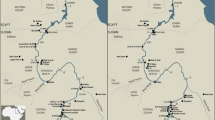Abstract
In East-Central Africa,1 both potting and potters were significant in the early social history of the region, and this importance challenges the generally accepted understanding of the role of both ceramic technology2 and ceramic producers in African history. Thus this study also disputes the works of some Western scholars who, after examining both iron smelting and potting, imposed faulty “paradigms” such as a strict division of labor by gender and the resulting “technology hierarchy” onto African societies.
… potters are of low socioeconomic status, [and] pots are often viewed as worthless bits of household paraphernalia …
(Rice 1991, 436)
Access this chapter
Tax calculation will be finalised at checkout
Purchases are for personal use only
Preview
Unable to display preview. Download preview PDF.
Similar content being viewed by others
References
VI Death. (no date). White fathers’ inquiry. Lusaka: White Fathers Archive, File10.
Ahmed [Saidi], Christine. 1996. Before Eve was Eve: 2200 years of gendered history in East-Central Africa. Ph.D. diss., University of California at Los Angeles.
Barley, Niger. 1984. Placing the West African potter. In Earthen ware in Asia and Africa, ed. John Picton, 93–103. London: School of Oriental & African Studies.
Berns, Marla C. 1993. Art, history and gender: Women and clay in West Africa. The African Anthropological Review: 129–48.
Bisson, M. S. 1974. Prehistoric copper mining in north-western Zambia. Archaeology XXVII: 242–47.
Bostoen, Koen A. G. 2005. Des mots et des pots en Bantou: Une approche linguistique de l’histoire de la ceramique en Afrique. Franfurt am Main: Peter Lang Publishing Group.
Corbeil, Jean J. 1982. Mbusa the Sacred Emblems. Original manuscript. Mbala, Zambia: Moto Moto Museum.
Cunnison, Ian. 1959. The Luapula Peoples of Northern Rhodesia: Custom and History in Tribal Politics. Manchester, UK: Manchester University Press.
Derricourt, Robin. 1986. Striated grinding grooves in central Africa. South African Archaeological Bulletin 41: 27–31.
Doke, Clement. 1931. The Lambas of Northern Rhodesia: A Study of Their Customs and Beliefs. London: George Harrap & Company Ltd.
Ehret, Christopher. 2002. The Civilizations of Africa: History to 1800. Charlottesville: University Press of Virginia.
—. 1998. The Classical Age: Eastern and Southern Africa in World History: 1000 BC to AD 400. Oxford, UK: Currey Publishing.
Etienne, F. 1962. Native Customs: A Study of the Babemba and the Neighboring Tribes. Lusaka: White Fathers’ Archive, Section 111/17.
Fowler, Ian. 1990. Banugo: A study of iron production: Trade and power in a nineteenth-century Ndop plain chiefdom. Ph.D. diss., University of London.
Gosselain, Oliver P. 1992. Technology and style: Potters and pottery among the Bahia of Cameroon. Man 27(3): 559–86.
Herbert, Eugenia. 1993. Iron, Gender and Power: Rituals of Transformation in African Societies. Bloomington and Indianapolis: Indiana University Press.
Hinefelaar, H. 1994. Bemba-speaking Women of Zambia in a Century of Religious Change (1892–1992). Leiden, Netherlands: E. J. Brill.
Kent, Susan, ed. 1998. Gender in African Prehistory. Walnut Creek: AltaMira Press.
Klieman, Kairn. 2003. The Pygmies Were Our Compass. Portsmouth, NH: Heinemann.
La Femme Bemba. (no date). Manuscript, Kuigisha, Illondola, Zambia: White Fathers Archive File 111/17.
Meillassoux, Claude. 1970. Le male engesine, ou de l’histoicite des myths. Cahiers d’Etudes Africaines 19: 355–80.
Mtonga, Napopa. (no date). The drama of Gule Wamkulu. M.A. thesis, University of Ghana, Legon.
Oyĕwùmí, Oyèrónké 1997. The Invention of Women: Making an African Sense of Western Gender Discourses. Minneapolis: University of Minnesota Press.
—. 1992. Mothers not women: Making an African sense of western gender discourse. Ph.D. diss., University of California, Berkeley.
Petit, Pierre. 1993. “Rites familiaux royaux. Etude du systeme ceremoniel des Luba du Shaba.” PhD diss., Universite Libre de Bruxelles, Belgium, 1993.
Poewe, Karla. 1981. Matrilineal Ideology: Male and Female Dynamics in Luapula, Zambia. London: International African Institute.
Richards, Audrey. 1982. Chisungu: A Girl’s Initiation Ceremony among the Bemba of Northern Rhodesia. London: Faber and Faber.
Rice, Prudence. 1991. Women and prehistoric pottery production. In The Archaeology of Gender: Proceedings of the Twenty-second Annual Conference of the Archaeological Association of the University of Calgary, ed. Dale Walde and Noreen D. Willow, 430–38. Calgary: University of Canada.
Rita-Ferreira, A. 1968. The Nyau brotherhood among the Mozambique Cewa. South African Journal of Science, January: 20–24.
Roberts, Andrew. 1976. A History of Zambia. New York: Africana Publishing Company.
Saidi, Christine. 2010. Women’s Authority and Society in Early East-African History. Rochester, NY: University of Rochester Press.
Scott, D. C., and A. Hetherwick. 1951. Dictionary of the Nyanja Language. London: Lutterworth Press.
Smith, Edwin, and Andrew Dale. 1920. The Ila-speaking Peoples of Northern Rhodesia. London: MacMillan and Co.
Editor information
Editors and Affiliations
Copyright information
© 2011 Oyèrónkẹ́ Oyĕwùmí
About this chapter
Cite this chapter
Saidi, C. (2011). NAKABUMBA: God Creates Humanity as a Potter Creates a Pot. In: Oyĕwùmí, O. (eds) Gender Epistemologies in Africa. Palgrave Macmillan, New York. https://doi.org/10.1057/9780230116276_10
Download citation
DOI: https://doi.org/10.1057/9780230116276_10
Publisher Name: Palgrave Macmillan, New York
Print ISBN: 978-1-349-38475-4
Online ISBN: 978-0-230-11627-6
eBook Packages: Palgrave Social Sciences CollectionSocial Sciences (R0)




